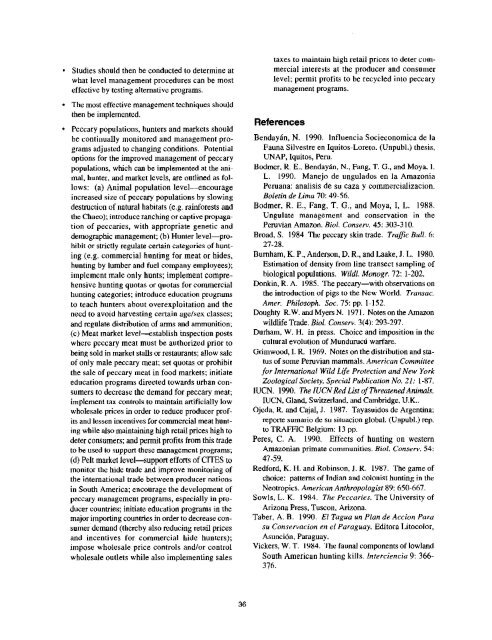Status Survey and Conservation Action Plan - IUCN
Status Survey and Conservation Action Plan - IUCN
Status Survey and Conservation Action Plan - IUCN
Create successful ePaper yourself
Turn your PDF publications into a flip-book with our unique Google optimized e-Paper software.
l<br />
l<br />
Studies should then be conducted to determine at<br />
what level management procedures can be most<br />
effective by testing alternative programs.<br />
The most effective management techniques should<br />
then be implemented.<br />
Peccary populations, hunters <strong>and</strong> markets should<br />
be continually monitored <strong>and</strong> management programs<br />
adjusted to changing conditions. Potential<br />
options for the improved management of peccary<br />
populations, which can be implemented at the animal,<br />
hunter, <strong>and</strong> market levels, are outlined as follows:<br />
(a) Animal population level-encourage<br />
increased size of peccary populations by slowing<br />
destruction of natural habitats (e.g. rainforests <strong>and</strong><br />
the Chaco); introduce ranching or captive propagation<br />
of peccaries, with appropriate genetic <strong>and</strong><br />
demographic management; (b) Hunter levelprohibit<br />
or strictly regulate certain categories of hunting<br />
(e.g. commercial hunting for meat or hides,<br />
hunting by lumber <strong>and</strong> fuel company employees);<br />
implement male only hunts; implement comprehensive<br />
hunting quotas or quotas for commercial<br />
hunting categories; introduce education programs<br />
to teach hunters about overexploitation <strong>and</strong> the<br />
need to avoid harvesting certain age/sex classes;<br />
<strong>and</strong> regulate distribution of arms <strong>and</strong> ammunition;<br />
(c) Meat market level-establish inspection posts<br />
where peccary meat must be authorized prior to<br />
being sold in market stalls or restaurants; allow sale<br />
of only male peccary meat; set quotas or prohibit<br />
the sale of peccary meat in food markets; initiate<br />
education programs directed towards urban consumers<br />
to decrease the dem<strong>and</strong> for peccary meat;<br />
implement tax controls to maintain artificially low<br />
wholesale prices in order to reduce producer profits<br />
<strong>and</strong> lessen incentives for commercial meat hunting<br />
while also maintaining high retail prices high to<br />
deter consumers; <strong>and</strong> permit profits from this trade<br />
to be used to support these management programs;<br />
(d) Pelt market level-support efforts of CITES to<br />
monitor the hide trade <strong>and</strong> improve monitoring of<br />
the international trade between producer nations<br />
in South America; encourage the development of<br />
peccary management programs, especially in producer<br />
countries; initiate education programs in the<br />
major importing countries in order to decrease consumer<br />
dem<strong>and</strong> (thereby also reducing retail prices<br />
<strong>and</strong> incentives for commercial hide hunters);<br />
impose wholesale price controls <strong>and</strong>/or control<br />
wholesale outlets while also implementing sales<br />
taxes to maintain high retail prices to deter commercial<br />
interests at the producer <strong>and</strong> consumer<br />
level; permit profits to be recycled into peccary<br />
management programs.<br />
Bendayan, N. 1990. Influencia Socieconomica de la<br />
Fauna Silvestre en Iquitos-Loreto. (Unpubl.) thesis,<br />
UNAP, Iquitos, Peru.<br />
Bodmer, R. E., Bendayan, N., Fang, T. G., <strong>and</strong> Moya, I.<br />
L. 1990. Manejo de ungulados en la Amazonia<br />
Peruana: analisis de su caza y commercialization.<br />
Boletin de Lima 70: 49-56.<br />
Bodmer, R. E., Fang, T. G., <strong>and</strong> Moya, I, L. 1988.<br />
Ungulate management <strong>and</strong> conservation in the<br />
Peruvian Amazon. Biol. Consew. 45: 303-3 10.<br />
Broad, S. 1984 The peccary skin trade. Trafic Bull. 6:<br />
27-28.<br />
Burnham, K. P., Anderson, D. R., <strong>and</strong> Laake, J. L. 1980.<br />
Estimation of density from line transect sampling of<br />
biological populations. WiZdZ. Monogr. 72: l-202.<br />
Donkin, R. A. 1985. The peccary-with observations on<br />
the introduction of pigs to the New World. Transac.<br />
Amer. Philosoph. Sot. 75: pp. l-152.<br />
Doughty R. W. <strong>and</strong> Myers N. 1971. Notes on the Amazon<br />
wildlife Trade. Biol. Conserv. 3(4): 293-297.<br />
Durham, W. H. in press. Choice <strong>and</strong> imposition in the<br />
cultural evolution of Mundurucu warfare.<br />
Grimwood, I. R. 1969. Notes on the distribution <strong>and</strong> status<br />
of some Peruvian mammals. American Committee<br />
for International Wild Life Protection <strong>and</strong> New York<br />
Zoological Society, Special Publication No. 21: l-87.<br />
<strong>IUCN</strong>. 1990. The <strong>IUCN</strong> Red List of Threatened Animals.<br />
<strong>IUCN</strong>, Gl<strong>and</strong>, Switzerl<strong>and</strong>, <strong>and</strong> Cambridge, U.K..<br />
Ojeda, R. <strong>and</strong> Cajal, J. 1987. Tayasuidos de Argentina:<br />
reporte sumario de su situation global. (Unpubl.) rep.<br />
to TRAFFIC Belgium: 13 pp.<br />
Peres, C. A. 1990. Effects of hunting on western<br />
Amazonian primate communities. Biol. Consew. 54:<br />
47-59.<br />
Redford, K. H. <strong>and</strong> Robinson, J. R. 1987. The game of<br />
choice: patterns of Indian <strong>and</strong> colonist hunting in the<br />
Neotropics. American Anthropologist 89: 650-667.<br />
Sowls, L. K. 1984. The Peccaries. The University of<br />
Arizona Press, Tuscan, Arizona.<br />
Taber, A. B. 1990. El Tagua un <strong>Plan</strong> de <strong>Action</strong> Para<br />
su <strong>Conservation</strong> en el Paraguay. Editora Litocolor,<br />
Asuncion, Paraguay.<br />
Vickers, W. T. 1984. The fauna1 components of lowl<strong>and</strong><br />
South American hunting kills. Interciencia 9: 366-<br />
376.<br />
36
















